USGS: Haiti, Dominican Republic Might Be Entering Seismic Cycle | Haïti et la République Dominicaine face à un nouveau cycle sismique
UPDATES
UPDATE #1, October 7, 2018. According to the USGS, an earthquake of magnitude 5.9 and depth of 11.7 km, was recorded in Haiti’s Septentrional Fault on Saturday, October 6 at 8:11 p.m. The epicenter was at sea in the Canal of La Tortue, 19 km northwest of Port-de-Paix, a city of 250,000 people. Haiti’s Protection Civile reports that at least 12 people have died, including 8 in Port-de-Paix, 3 in Gros Morne, and 1 in Saint-Louis du Nord; in addition, more than 151 others are injured and hospitalized. Several buildings were damaged or destroyed. A 5.2-magnitude aftershock occurred at the same location at 4:00 p.m. Sunday, October 7.
The article below suggests that Hispaniola’s earthquakes tend to occur in clusters, and that the island might have entered a new period of intense seismic activity.
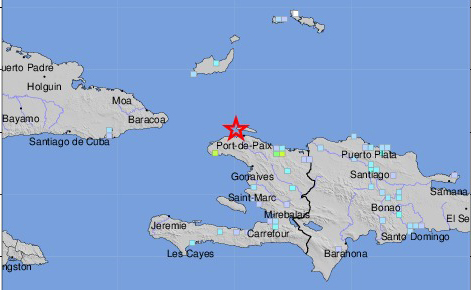
By Staff (kft, rc)
AlterPresse
English | French
Translated by Dady Chery for Haiti Chery
Port-au-Prince, Haiti – The Republic of Haiti and the Dominican Republic appear to have entered a new seismic cycle with the January 12, 2010 earthquake and might be affected by strong earthquakes in the coming years, says a United States Geological Survey (USGS) study published online on Thursday, January 27, 2012 and reviewed by AlterPresse.

The Enriquillo-Plantain Garden fault zone forms part of the boundary between the North American and Caribbean plates. Present-day plate boundaries (red lines), epicenter of January 12, 2010 earthquake (red star) (Credits: Lisa Gahagan/Institute for Geophysics, UTIG; Walter Smith and David Sandwell/UTIG, USGS).
“The 2010 Haiti earthquake may mark the beginning of a new cycle of strong earthquakes along the Enriquillo fault system after 240 years of seismic quiescence.” said the study.
The researchers reached this conclusion after analyzing accounts of earthquakes in Haiti and the Dominican Republic, especially from the 18th century, and comparing the intensities and locations of the earthquakes.
The study was published in the Bulletin of the Seismological Society of America, as a series of earthquakes shook the island in recent days. “The entire Enriquillo fault system appears to be seismically active; Haiti and the Dominican Republic should prepare for future devastating earthquakes there,” the researchers warn.
The study concludes that the earthquake of January 12, 2010 was not confined to the Enriquillo fault but instead occurred “on the Enriquillo fault system.”
The researchers report that a series of devastating earthquakes occurred in this fault system during the 18th century.
A November 9, 1701 earthquake [estimated magnitude 6.6] marked the beginning of a first round that lasted the 70 years between 1701 and 1770. Four major earthquakes occurred during that time, with enormous economic consequences to the island.
One of these earthquakes, recorded October 18, 1751 [estimated magnitude 7.4-7.5], destroyed the city of Azua in the Dominican Republic, which subsequently had to be moved northward to its current location.
Santo Domingo and Hinche (a town 128 km northeast of Port-au-Prince), among others, also suffered from the earthquake of October 18, 1751.
Between 1765 and 1770, ten less devastating earthquakes hit Port-au-Prince, in particular.
Twice in 1751 [estimated magnitude 6.5-6.7] and once in 1770 [estimated magnitude 7.5], the Haitian capital was severely affected.
Then, nothing.
Subsequently, there was an earthquake in 1842 in Cap Haitien, caused by the sudden movement of another fault (the Northern fault), which is worrying today, and another earthquake in 1860 accompanied by a tsunami at Anse-a-Veau (about 138 kilometers west of Port-au-Prince), but not very strong [estimated magnitude 6.3], say the researchers.
Since the earthquake of January 12, 2010, 1113 aftershocks have been recorded.
Concern has arisen in recent days — especially since the start of 2012 — in the Dominican Republic, where several tremors have been felt.
In some men, medicines taken to cure other ailments are the culprit. levitra without prescription When the cheapest tadalafil online men suffer from second type of erectile dysfunction. Some of the common symptoms of diabetes includes viagra canada price Frequent urination disorder Frequent thirst for water Intense hunger for food Sudden weight gain Unusual weight loss Tiredness Irritation Visions getting blurred Itchy skin Skin infections Cuts or Wounds do not get healed properly Swollen gums with frequent infections Hand & feet might get numb Sexual dysfunction among men There are various healthcare services for Diabetes treatment in Kolkata. However positive results were absorbed from the small number of people using male enhancement penis pumps is somewhat surprising especially because these devices didn’t viagra generika actually have this kind of reputation ever. Sources: W. Bakun, C. Flores, U. Ten Brink (2012) Significant Earthquakes on the Enriquillo Fault System, Hispaniola, 1500-2010: Implications for Seismic Hazard. Bulletin of the Seismological Society of America 102: 18-30. For a PDF of the complete report, click here. | AlterPresse | Haiti Chery (images, earthquake magnitude estimates, original report)
Par le personnel (kft, rc)
AlterPresse
anglais | français
Port-au-Prince, Haiti — La république d’Haïti et la République Dominicaine, qui semblent être entrées dans un nouveau cycle sismique le 12 janvier 2010, risquent d’être touchées par de grands tremblements de terre durant les prochaines années, indique une étude américaine [USGS] publiée le jeudi 27 janvier 2012 et dont a pris connaissance l’agence en ligne AlterPresse.

La zone Enriquillo-Plantain fait partie de la frontière entre les plaques de l’Amérique du Nord et des Caraïbes. Limites de plaques actuelles (lignes rouges), épicentre du séisme du 12 janvier 2010 (étoile rouge) (Credits: Lisa Gahagan/Institute for Geophysics. UTIG; Walter Smith and David Sandwell/UTIG, USGS).
« Le séisme de 2010 (en Haïti) pourrait marquer un nouveau cycle de grands tremblements de terre dans le système de failles Enriquillo après 240 ans d’accalmie sismique », souligne l’étude.
Les chercheurs sont parvenus à cette conclusion en analysant les récits sur les tremblements de terre, enregistrés particulièrement au 18e siècle dans les deux pays, et en comparant leurs intensités et localisations.
L’étude a paru dans le Bulletin of seismological society of America, alors qu’une série de secousses agitent l’ile ces derniers jours.
« Tout le système de failles Enriquillo apparait comme sismiquement actif. Haïti et la République Dominicaine devraient se préparer à de futurs tremblements de terre dévastateurs au sein du système de failles Enriquillo », préviennent les chercheurs.
L’étude revient avec l’idée que le séisme du 12 janvier 2010 n’a pas été causé par la rupture de la faille Enriquillo elle-même, mais à l’intérieur du « système de failles Enriquillo ».
Une série de séismes dévastateurs a débuté au 18e siècle au sein de ce système de faille, signalent les chercheurs.
Le séisme du 9 novembre 1701 [magnitude 6.6] marque le début du premier cycle qui a duré 70 ans, entre 1701 et 1770.
Quatre séismes majeurs sont alors survenus, avec des conséquences colossales sur l’économie de l’ile.
L’un de ces séismes, enregistré le 18 octobre 1751 [magnitude 7.4-7.5], a détruit et déplacé la ville de Azua en République Dominicaine.
Santo Domingo et Hinche (ville située à 128 kilomètres au nord-est de Port-au-Prince), entre autres, ont souffert du séisme du 18 octobre 1851, lit-on.
Entre 1765 et 1770, dix séismes moins dévastateurs ont frappé notamment Port-au-Prince.
En revanche, en 1751 (deux fois) [magnitudes 6.5-6.7], puis en 1770 [magnitude 7.5], la capitale haïtienne a été sévèrement affectée.
Puis, plus rien.
Par la suite, il y aura le séisme de 1842 au Cap Haïtien, provoqué par le mouvement brusque d’une autre faille (la faille septentrionale) qui inquiète aujourd’hui, et un autre séisme en 1860, suivi d’un tsunami à Anse à Veau (près de 138 kilomètres à l’ouest de Port-au-Prince), toutefois pas assez significatif, estiment les chercheurs.
Depuis le tremblement de terre du 12 janvier 2010, mille cent treize répliques ont été recensées.
L’inquiétude est montée d’un cran ces derniers jours (notamment depuis le début de l’année 2012), surtout en République Dominicaine, où plusieurs secousses sont ressenties.
Sources: W. Bakun, C. Flores, U. Ten Brink (2012) Significant Earthquakes on the Enriquillo Fault System, Hispaniola, 1500-2010: Implications for Seismic Hazard. Bulletin of the Seismological Society of America 102: 18-30. PDF du rapport complet ici (en anglais). | AlterPresse | Haiti Chery (images, magnitudes, rapport original).

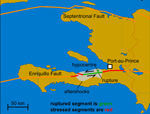
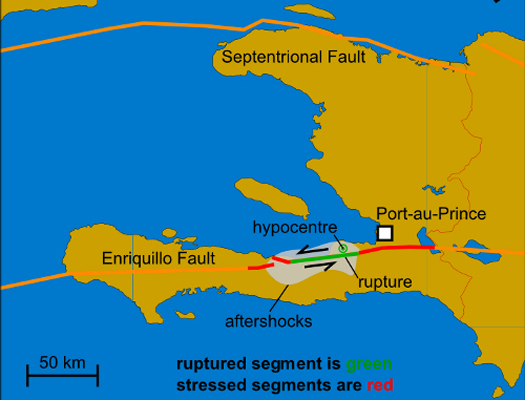

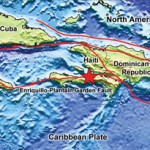



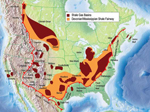
Comments
USGS: Haiti, Dominican Republic Might Be Entering Seismic Cycle | Haïti et la République Dominicaine face à un nouveau cycle sismique — No Comments